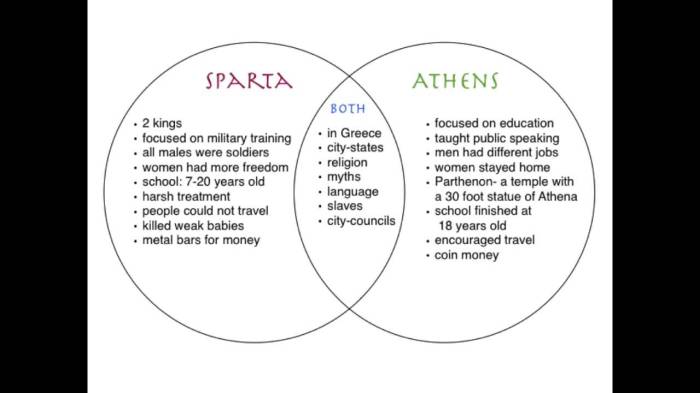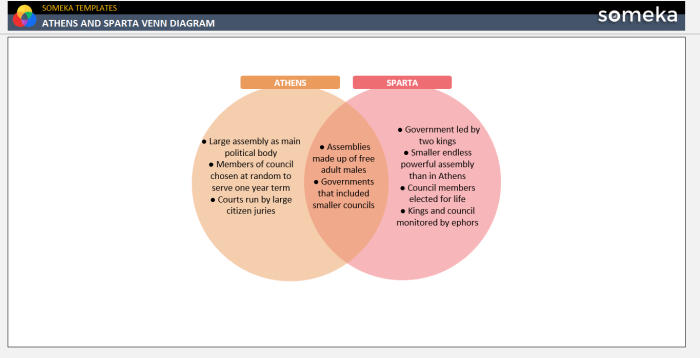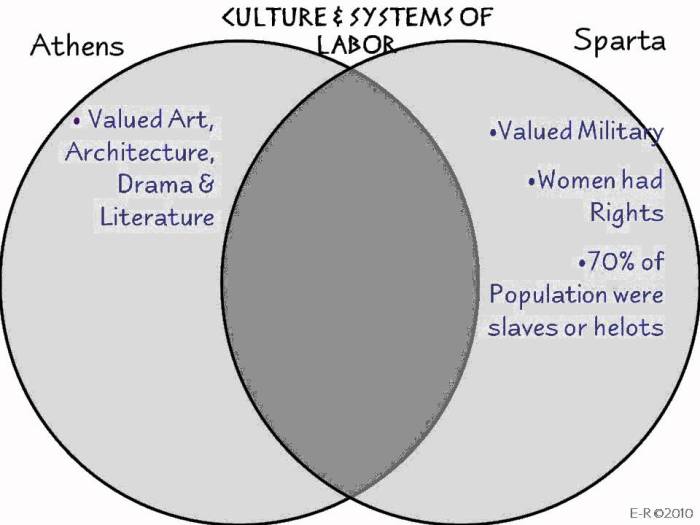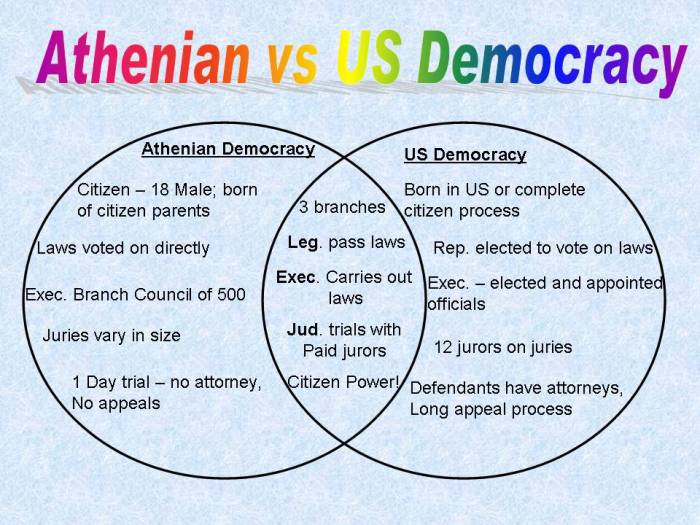Venn diagram athens vs sparta – Embark on an intriguing journey with our Venn diagram of Athens and Sparta, two colossal city-states whose contrasting legacies continue to captivate. Dive into their unique histories, military prowess, cultural achievements, and more, as we illuminate the fascinating tapestry of ancient Greece.
Their distinct geographical locations, political systems, and social structures laid the foundation for a rivalry that shaped the course of Western civilization. Prepare to witness the clash of ideas and ideologies as we explore the strengths and weaknesses of each city-state, unraveling the complexities that made them both formidable and unforgettable.
History and Origins

Athens and Sparta, two prominent city-states in ancient Greece, played pivotal roles in shaping Greek history and civilization. Their distinct geographical locations, political systems, and social structures influenced their development and contributed to their enduring legacy.
Athens, located in Attica, was a maritime city with a thriving port and access to trade routes. This strategic location fostered its commercial and cultural development. Sparta, on the other hand, was situated in the Peloponnese region and had a more inland location.
Its geography emphasized military strength and discipline.
Political Systems
Athens was a democracy, with citizens participating in decision-making through the Assembly and other institutions. In contrast, Sparta had an oligarchic system dominated by a small elite of warriors known as the Spartiates.
Social Structures
Athenian society was more open and diverse, with citizens pursuing a range of occupations. Sparta, on the other hand, had a rigidly stratified social structure based on military service. The Spartiates were the warrior elite, while the helots were state-owned slaves who worked the land.
Military Strength and Warfare
Athens and Sparta, the two prominent city-states of ancient Greece, possessed distinct military strategies and strengths. While Athens relied on its powerful navy and citizen-soldiers, Sparta emphasized rigorous military training and a professional army.
Military Strategies
Athens, with its maritime dominance, employed naval warfare as its primary strategy. Its fleet of triremes, swift and maneuverable warships, allowed Athens to control sea trade and project power beyond its borders. In contrast, Sparta focused on land warfare, relying on its disciplined hoplite phalanx, a formation of heavily armed infantrymen.
Strengths and Weaknesses
Athens’ naval superiority gave it an advantage in controlling sea routes and securing resources. Its citizen-soldiers, though less rigorously trained than Spartan hoplites, were highly motivated and fought fiercely for their city. However, Athens’ reliance on a citizen army made it vulnerable to manpower shortages during prolonged conflicts.
Sparta’s professional army, composed of rigorously trained hoplites, was renowned for its discipline and battlefield prowess. Its hoplite phalanx, a tightly packed formation of heavily armored soldiers, was nearly invincible in close combat. However, Sparta’s limited resources and lack of a navy restricted its ability to project power beyond the Peloponnese.
Geography’s Impact
Geography played a significant role in shaping the military strategies of both city-states. Athens’ coastal location and access to the Aegean Sea allowed it to develop a maritime empire. Sparta, situated inland in the Peloponnese, focused on land warfare and territorial expansion within the region.
Cultural and Intellectual Achievements

Athens and Sparta, two prominent city-states in ancient Greece, possessed distinct cultural and intellectual landscapes shaped by their contrasting political and social systems.
Athenian culture flourished in a democratic society that valued individual expression and intellectual inquiry. Sparta, on the other hand, maintained a militaristic oligarchy that emphasized obedience and discipline.
Education
Education in Athens focused on developing well-rounded citizens with a broad understanding of literature, philosophy, and the arts. Spartan education, in contrast, prioritized military training and physical fitness.
Art
Athenian art showcased naturalism, realism, and humanism. Sculptures and paintings depicted idealized forms and explored themes of mythology and human emotion. Spartan art, on the other hand, was functional and austere, with a focus on military subjects.
Philosophy
Athens was the birthplace of Western philosophy, with thinkers such as Socrates, Plato, and Aristotle shaping the foundations of logic, ethics, and metaphysics. Sparta, with its emphasis on military prowess, did not produce notable philosophers.
Economic Structures and Trade
Athens and Sparta, two prominent city-states in ancient Greece, had distinct economic systems and approaches to trade and commerce.
Athens, known for its maritime prowess, developed a thriving commercial economy based on trade and industry. Its strategic location on the Aegean Sea allowed it to engage in extensive trade with other Greek city-states, as well as with regions across the Mediterranean.
The Venn diagram comparing Athens and Sparta is a great resource for understanding the differences between these two ancient Greek city-states. If you’re looking for a quick reference guide to help you study for your ACLS post-test, check out this ACLS post test answer key PDF . It covers all the key concepts you need to know about Athens and Sparta, including their political systems, military strategies, and cultural achievements.
Returning to the Venn diagram, it’s clear that while Athens and Sparta had some similarities, they were also very different in many ways.
Athenian Economic System
- Athens had a market-oriented economy with a large merchant class.
- The city produced goods such as pottery, olive oil, and wine for export.
- Athens imported raw materials, such as grain and timber, to support its growing population and industries.
- The city had a sophisticated financial system, including banks and a developed currency.
In contrast, Sparta’s economy was primarily based on agriculture and military conquest.
Spartan Economic System
- Sparta had a highly regimented economy, with land ownership concentrated in the hands of a small elite class.
- The majority of the population were helots, state-owned serfs who worked the land and provided labor.
- Sparta produced primarily agricultural goods, such as wheat and barley, for domestic consumption.
- Trade and commerce were discouraged, as they were seen as a distraction from military training and discipline.
The geographic location of Athens and Sparta also played a significant role in their economic development. Athens’ access to the sea allowed it to become a major trading hub, while Sparta’s inland location limited its trade opportunities.
Political and Social Tensions: Venn Diagram Athens Vs Sparta

Athens and Sparta, the two most prominent city-states in ancient Greece, were vastly different in their political and social structures. These differences led to tensions between the two cities, which eventually culminated in the Peloponnesian War.
In Athens, power was vested in the hands of the people through a system of direct democracy. All male citizens over the age of 18 were eligible to participate in the Assembly, which made laws, declared war, and elected officials.
This system gave rise to a highly active and engaged citizenry, which took pride in its role in governing the city.
In contrast, Sparta was ruled by a small elite of aristocratic families. Power was concentrated in the hands of two kings, who were advised by a council of elders. The Spartan citizenry had little say in the running of the city, and their primary role was to serve as soldiers in the army.
These differences in political structure led to a number of social tensions between Athens and Sparta. Athenians viewed Spartans as backward and oppressive, while Spartans viewed Athenians as undisciplined and chaotic. These tensions were further exacerbated by the fact that Athens was a maritime power, while Sparta was a land power.
This led to competition for resources and territory, which further strained relations between the two cities.
The Peloponnesian War
The Peloponnesian War (431-404 BC) was a direct result of the tensions between Athens and Sparta. The war began when Athens formed an alliance with the city of Corcyra, which was a rival of Corinth, a Spartan ally. Sparta responded by forming an alliance with Thebes and other Peloponnesian states, and the two sides went to war.
The war lasted for 27 years and was fought on land and sea. Athens initially had the upper hand, but Sparta eventually gained the advantage. The war ended with the defeat of Athens and the collapse of the Athenian Empire.
The Peloponnesian War had a profound impact on both Athens and Sparta. Athens lost its empire and its status as the leading city-state in Greece. Sparta, on the other hand, emerged from the war as the dominant power in Greece.
Legacy and Impact

The legacy of Athens and Sparta on Western civilization is profound. Athenian ideals of democracy, philosophy, and the arts continue to inspire and shape modern societies. Spartan values of discipline, courage, and military prowess have also left a lasting mark.
Influence on Modern Society
- Athenian ideas of democracy and self-government have influenced the development of modern democratic systems around the world.
- Spartan military tactics and training methods have been adopted by modern armies.
- Athenian philosophers such as Socrates, Plato, and Aristotle have had a major impact on Western thought and education.
Rivalry in Popular Culture, Venn diagram athens vs sparta
The rivalry between Athens and Sparta continues to resonate in popular culture. For example:
- The movie “300” (2006) depicts the Battle of Thermopylae, where a small Spartan force held off a massive Persian army.
- The video game “Assassin’s Creed: Odyssey” (2018) allows players to explore ancient Greece during the Peloponnesian War.
- The TV show “Spartacus” (2010-2013) tells the story of a slave rebellion against the Roman Republic, which was inspired by the Spartan uprising against the Athenians.
FAQ Section
What were the key differences between Athenian and Spartan education?
Athenian education focused on developing well-rounded individuals through philosophy, literature, and the arts, while Spartan education prioritized physical fitness and military training.
How did geography influence the economic development of Athens and Sparta?
Athens’ proximity to the sea facilitated trade and commerce, while Sparta’s inland location made agriculture its primary economic activity.
What was the significance of the Peloponnesian War in the rivalry between Athens and Sparta?
The Peloponnesian War was a protracted conflict that weakened both city-states and ultimately led to the decline of Athenian power.